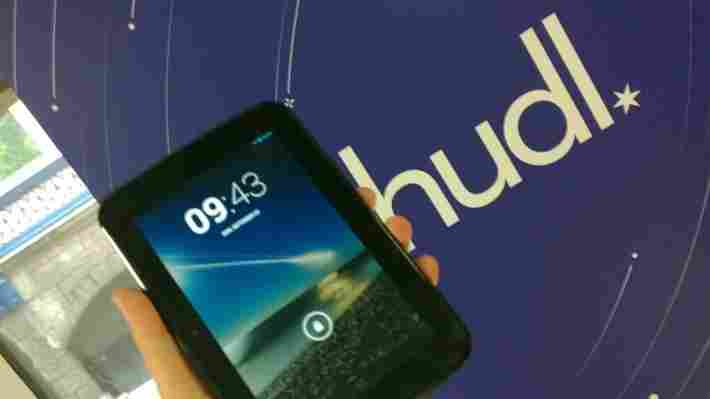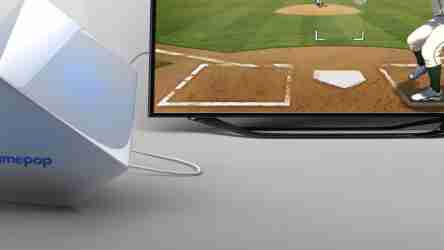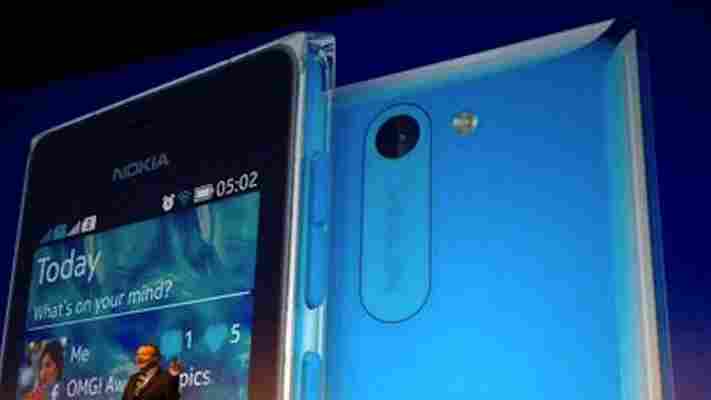Tesco’s freshly launched Hudl tablet is an interesting proposition from the international supermarket retailer chain. Although available only in the UK for now, the device promises to bring trouble-free and familiy-friendly computing to the masses and could later see international availability.

For just £119 – or by using Tesco’s Points Boost offer, just £60 worth of vouchers – the Hudl is likely to tempt shoppers browsing the aisles, particularly those that don’t live at the cutting-edge of tech.
First impressions from our hands-on time with the Hudl were good, and somewhat allay concerns of yet another low-cost, but inferior performing tablet flooding onto the market.
In our brief hands-on testing, the 1440 x 900 pixel display seemed to show colors and images crisply enough, without the feeling that you’re getting more fuzz than anything else. Sure, it’s not 1080p, but at this price, it would be more surprising if it was.
One thing that we did notice, and while not a huge problem, was that the display is not quite as responsive as some more premium models. That said, it wasn’t unresponsive and didn’t require too much pawing at the screen to achieve what you want to do.
Similarly, for the £119, Tesco has done well to fit a 1.5GHz quad-core processor in the device and 16GB of storage too. While our testing was admittedly limited there was no sign of slowing down or buckling under the pressure. It’s also a smart move to include a micro HDMI output too, for playing back media on the big screen.
Where the tablet will most appeal to buyers, beyond its tech specs, is in the familiarity of a household name and a nationwide selection of stores that it can be returned to if there’s a problem.
Tesco has also taken the opportunity to differentiate the device from others in a similar price range by integrating its BlinkBox Music and BlinkBox video-on-demand services into the tablet.
Along with shortcuts to the user’s online Tesco account to manage things like deliveries and clubcard points, the BlinkBox services can be accessed by clicking the small ‘T’ icon in the bottom left-hand corner of the main screen.
The overall size and weight of the device is very manageable too – with the biggest criticism being that it does feel very plasticky – which is unsurprising given it’s a budget Android 4.2.2 tablet that’s made out of plastic.
Nonetheless, it doesn’t feel flimsy – and docking it into one of the optional extra cases (which also double as a stand to prop it up horizontally – priced at around £20) would likely provide a little extra protection.
Also on-board is a forward-facing 2-megapixel camera and a read-facing 3-megapixel snapper – neither of which we got a chance to test properly so will withhold judgement for now. Needless to say, it’s unlikely to be the best part of the tablet, but it’s potentially handy to have and appeals for parents giving the tablets to their children.
As this is one of the target markets for the Hudl, Tesco has also made it easy to set the tablet up for sharing with little ones, to ensure they don’t get access to content and services that they really shouldn’t.
We see a lot of premium and budget tablets alike pass through our hands but with the latter always comes the fear that the compromise to keep the cost down will have in some other way crippled the device.
However, with the Hudl, Tesco has managed to include all the core specs that we’d like to see on a tablet in this range, without having to give up things like the screen resolution. Granted, there’s no 3G/4G option, so connectivity is limited to WiFi but the price has to be kept down somewhere, and it’s not really the sort of feature that would appeal to families and casual users – the target market for the Hudl.
It also has a leg-up ahead of other bargain basement devices by being made by a company that also owns streaming services for video, TV and music – with BlinkBox Books just over the horizon.
Couple this with launch offers from Tesco that will see the value of BlinkBox vouchers doubled for a time-limited period and the company will likely see a huge influx in the number of users on the platform – likely one of the secondary concerns (at the least) in launching it own tablet. Interestingly though, Tesco said it is in fact making money of the devices themselves, so it’s clearly not just a play to drive usage of BlinkBox alone.
I’d be surprised if this is the last own-brand consumer electronics device from Tesco in the UK, to me it feels like it’s just getting started – and its a contender worth taking note of if the Hudl is anything to go by.
Look ma, I’m playing iOS apps on the TV! BlueStacks’ GamePop console is no longer Android-only
Silicon Valley company BlueStacks is announcing news at a rapid, constant pace these days as it aims to capitalize on the trend of bringing mobile games that are typically only playable on smartphones or tablets into the living room and onto television sets.

First it made some waves announcing GamePop , an Android video gaming console combined with a $6.99/month all-you-can-eat game subscription service that will essentially enable customers to play a wide range of mobile games on the big screen after installing a Boxee-style set-top box.
Then, it announced that the hardware would cost $129 (this is on top of the subscription fee, which allows users to play as many games from the catalog as they wish, Netflix-style), and that it had added a bunch of games from several developers to the line-up.
Today, the company is announcing the ability to include iPhone and iPad applications under the GamePop service umbrella, signing up ‘Fieldrunners’ maker Subatomic Studios for starters.
The iOS apps are powered by a new, so-called “Mobile-to-TV technology” called Looking Glass. BlueStacks CTO Suman Saraf explains:
Apu Kumar, the venture capital-backed company’s SVP of Global Sales and Business Development, added:
The company isn’t sharing much about the GamePop box and controller specs but points out that its investors include the likes of Intel, Qualcomm and AMD, which coincidentally also produces the chipsets for both the upcoming Xbox One and PS4 consoles.
You can pre-order the GamePop console now.
No word on when the things will start shipping to customers, but the FAQ speaks of a “winter release”.
Up until now, BlueStacks was best known for its App Player software , which now caters to 10 million users who want to play their favourite mobile games on a Mac or PC desktop computer.
Like OUYA’s gaming box, its GamePop console runs on Android (Jelly Bean 4.2), and the technology that went into the hardware is completely separate from BlueStacks’ aforementioned App Player software.
Games are stored on the console itself.
Aside from the aforementioned investors, BlueStacks is also backed by the likes of Citrix and Andreessen Horowitz.
Meanwhile, Kickstarter darling OUYA is gearing up to start selling its own Android-based video game console in retail stores at the end of next month, backed by a fresh $15 million in VC funding from Kleiner Perkins, NVIDIA and others.
The OUYA console costs $99, but games need to be bought separately.
Nokia announces Asha 500 for $69, Asha 502 for $89, and Asha 503 for $99
At Nokia World in Abu Dhabi today, Nokia expanded its Asha Platform family of devices with the Asha 500, Asha 502, and Asha 503. All three will be available in bright red, bright green, yellow, cyan, white, and black in Q4 2013.

(Scroll down to see the first video of all three Asha devices)
The Nokia Asha 500 features a 2.8-inch screen, 2MP camera, and comes in single SIM and Easy Swap Dual SIM variants. It will ship for $69 in Africa, Asia-Pacific, Europe, Latin America, and the Middle East.
The Nokia Asha 502 features a 3-inch screen, a 5MP camera with LED flash, and Easy Swap Dual-SIM. It will ship for $89 in Africa, Asia-Pacific, Europe, and the Middle East.
The Asha 503 features 3.5G connectivity, a 3-inch screen, 5MP camera with LED flash, Corning Gorilla Glass 2, and comes in single SIM and Easy Swap Dual SIM variants. It will ship for $99 in Africa, Asia-Pacific, Europe, Latin America, and the Middle East.
The Nokia Asha 500, Asha 502 and Asha 503 come with a new Asha user interface that Nokia says “enables faster and easier sharing of images on social networks” thanks to one-swipe access to the camera and a one-touch posting option. Fastlane gives people a second home screen for quick access to frequently used apps and deeper integration with their favourite social networks.
Nokia highlighted that the newest Asha phones will come with Nimbuzz Messenger, the first Asha app supporting VoIP telephony. This means users will be able to make domestic and international low-cost phone calls to other mobile phones as well as landlines.
Additional apps coming to Asha phones include: Danger Dash, ESPN F1, ESPN FC, ESPN Hub, Goal Live Scores, LINE with Free Voice Calls, Photofunia, PicFeed, and PicTag. WhatsApp will be available for the Nokia Asha 501 in November, with support for the new Nokia Asha 500, Asha 502, and Asha 503 said to be “coming soon.”
Here’s an assortment of the colorful, budget devices and a hands-on video:
Images via TNW, product images via Nokia
